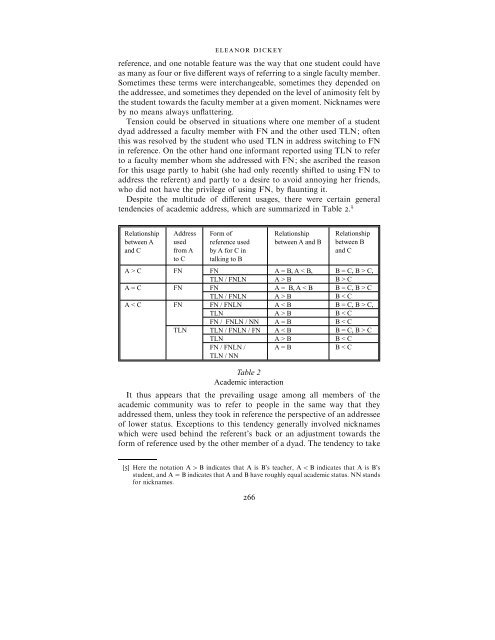Forms of address and terms of reference - Exeter Research and ...
Forms of address and terms of reference - Exeter Research and ...
Forms of address and terms of reference - Exeter Research and ...
You also want an ePaper? Increase the reach of your titles
YUMPU automatically turns print PDFs into web optimized ePapers that Google loves.
eleanor dickey<br />
<strong>reference</strong>, <strong>and</strong> one notable feature was the way that one student could have<br />
as many as four or five different ways <strong>of</strong> referring to a single faculty member.<br />
Sometimes these <strong>terms</strong> were interchangeable, sometimes they depended on<br />
the <strong>address</strong>ee, <strong>and</strong> sometimes they depended on the level <strong>of</strong> animosity felt by<br />
the student towards the faculty member at a given moment. Nicknames were<br />
by no means always unflattering.<br />
Tension could be observed in situations where one member <strong>of</strong> a student<br />
dyad <strong>address</strong>ed a faculty member with FN <strong>and</strong> the other used TLN; <strong>of</strong>ten<br />
this was resolved by the student who used TLN in <strong>address</strong> switching to FN<br />
in <strong>reference</strong>. On the other h<strong>and</strong> one informant reported using TLN to refer<br />
to a faculty member whom she <strong>address</strong>ed with FN; she ascribed the reason<br />
for this usage partly to habit (she had only recently shifted to using FN to<br />
<strong>address</strong> the referent) <strong>and</strong> partly to a desire to avoid annoying her friends,<br />
who did not have the privilege <strong>of</strong> using FN, by flaunting it.<br />
Despite the multitude <strong>of</strong> different usages, there were certain general<br />
tendencies <strong>of</strong> academic <strong>address</strong>, which are summarized in Table 2.<br />
Relationship<br />
between A<br />
<strong>and</strong> C<br />
A > C<br />
A = C<br />
A < C<br />
Address<br />
used<br />
from A<br />
to C<br />
FN<br />
FN<br />
FN<br />
TLN<br />
Form <strong>of</strong><br />
<strong>reference</strong> used<br />
by A for C in<br />
talking to B<br />
FN<br />
TLN / FNLN<br />
FN<br />
TLN / FNLN<br />
FN / FNLN<br />
TLN<br />
FN / FNLN / NN<br />
TLN / FNLN / FN<br />
TLN<br />
FN / FNLN /<br />
TLN / NN<br />
Relationship<br />
between A <strong>and</strong> B<br />
A = B, A < B,<br />
A > B<br />
A = B, A < B<br />
A > B<br />
A < B<br />
A > B<br />
A = B<br />
A < B<br />
A > B<br />
A = B<br />
Relationship<br />
between B<br />
<strong>and</strong> C<br />
B = C, B > C,<br />
B > C<br />
B = C, B > C<br />
B < C<br />
B = C, B > C,<br />
B < C<br />
B < C<br />
B = C, B > C<br />
B < C<br />
B < C<br />
Table 2<br />
Academic interaction<br />
It thus appears that the prevailing usage among all members <strong>of</strong> the<br />
academic community was to refer to people in the same way that they<br />
<strong>address</strong>ed them, unless they took in <strong>reference</strong> the perspective <strong>of</strong> an <strong>address</strong>ee<br />
<strong>of</strong> lower status. Exceptions to this tendency generally involved nicknames<br />
which were used behind the referent’s back or an adjustment towards the<br />
form <strong>of</strong> <strong>reference</strong> used by the other member <strong>of</strong> a dyad. The tendency to take<br />
[5] Here the notation A B indicates that A is B’s teacher, A B indicates that A is B’s<br />
student, <strong>and</strong> A B indicates that A <strong>and</strong> B have roughly equal academic status. NN st<strong>and</strong>s<br />
for nicknames.<br />
266
















